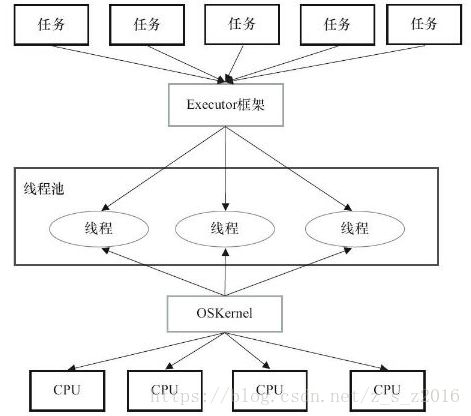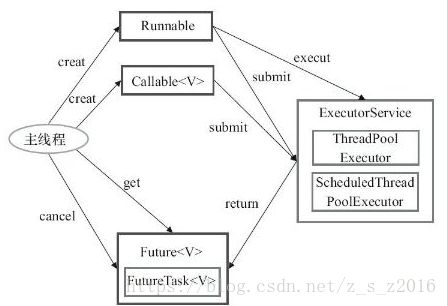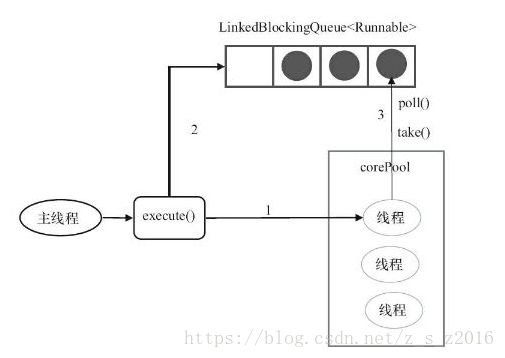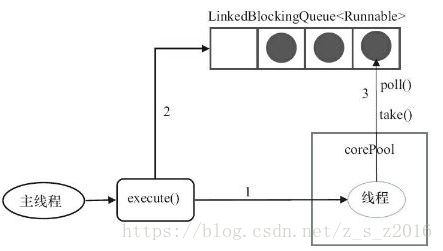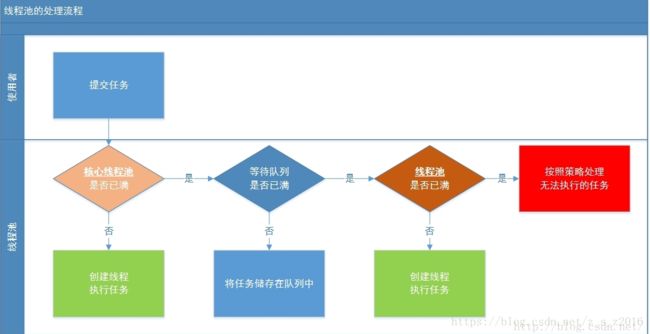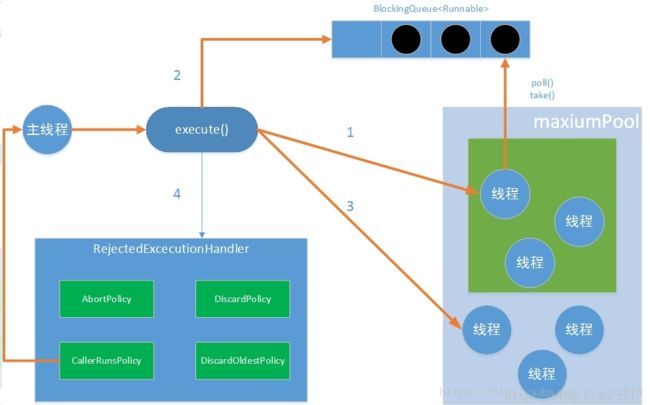Java线程池-ThreadPoolExecutor原理分析与实战
1. 为什么要用线程池
- 减少资源的开销
减少了每次创建线程、销毁线程的开销。 - 提高响应速度 ,每次请求到来时,由于线程的创建已经完成,故可以直接执行任务,因此提高了响应速度。
- 提高线程的可管理性 ,线程是一种稀缺资源,若不加以限制,不仅会占用大量资源,而且会影响系统的稳定性。 因此,线程池可以对线程的创建与停止、线程数量等等因素加以控制,使得线程在一种可控的范围内运行,不仅能保证系统稳定运行,而且方便性能调优。
2. Executor接口
由上可知,ThreadPoolExecutor是线程池的真正实现,通过构造方法的一系列参数,来构成不同配置的线程池
1) Executor两级调度模型
在HotSpot虚拟机中,Java中的线程将会被一一映射为操作系统的线程 在Java虚拟机层面,用户将多个任务提交给Executor框架,Executor负责分配线程执行它们; 在操作系统层面,操作系统再将这些线程分配给处理器执行
2) Executor结构
Executor框架中的所有类可以分成三类:
- 任务
任务有两种类型:Runnable和Callable。 - 任务执行器
Executor框架最核心的接口是Executor,它表示任务的执行器。
Executor的子接口为ExecutorService。
ExecutorService有两大实现类:ThreadPoolExecutor和ScheduledThreadPoolExecutor。 - 执行结果
Future接口表示异步的执行结果,它的实现类为FutureTask。
3) 四种类型的线程池
1. FixedThreadPool 定长线程池
public static ExecutorService newFixedThreadPool(int nThreads) {
return new ThreadPoolExecutor(nThreads, nThreads, 0L, TimeUnit.MILLISECONDS, new LinkedBlockingQueue());
}
- 它是一种固定大小的线程池;
- corePoolSize和maximunPoolSize都为用户设定的线程数量nThreads;
- keepAliveTime为0,意味着一旦有多余的空闲线程,就会被立即停止掉;但这里keepAliveTime无效;
- 阻塞队列采用了LinkedBlockingQueue,它是一个无界队列;
- 由于阻塞队列是一个无界队列,因此永远不可能拒绝任务;
- 由于采用了无界队列,实际线程数量将永远维持在nThreads,因此maximumPoolSize和keepAliveTime将无效。
2. CachedThreadPool 可缓存线程池
public static ExecutorService newCachedThreadPool(){
return new ThreadPoolExecutor(0,Integer.MAX_VALUE,60L,TimeUnit.MILLISECONDS,new SynchronousQueue());
} - 它是一个可以无限扩大的线程池;
- 它比较适合处理执行时间比较小的任务;
- corePoolSize为0,maximumPoolSize为无限大,意味着线程数量可以无限大;
- keepAliveTime为60S,意味着线程空闲时间超过60S就会被杀死;
- 采用SynchronousQueue装等待的任务,这个阻塞队列没有存储空间,这意味着只要有请求到来,就必须要找到一条工作线程处理他,如果当前没有空闲的线程,那么就会再创建一条新的线程。
3. SingleThreadExecutor 单一线程池
public static ExecutorService newSingleThreadExecutor(){
return new ThreadPoolExecutor(1,1,0L,TimeUnit.MILLISECONDS,new LinkedBlockingQueue());
} - 它只会创建一条工作线程处理任务;
- 采用的阻塞队列为LinkedBlockingQueue;
4. ScheduledThreadPool 可调度的线程池
它用来处理延时任务或定时任务。
- 它接收SchduledFutureTask类型的任务,有两种提交任务的方式:
- scheduledAtFixedRate
- scheduledWithFixedDelay
- SchduledFutureTask接收的参数:
- time:任务开始的时间
- sequenceNumber:任务的序号
- period:任务执行的时间间隔
- 它采用DelayQueue存储等待的任务
- DelayQueue内部封装了一个PriorityQueue,它会根据time的先后时间排序,若time相同则根据sequenceNumber排序;
- DelayQueue也是一个无界队列;
- 工作线程的执行过程:
- 工作线程会从DelayQueue取已经到期的任务去执行;
- 执行结束后重新设置任务的到期时间,再次放回DelayQueue
3. 线程池的处理流程
一个线程从被提交(submit)到执行共经历以下流程:
- 线程池判断核心线程池里是的线程是否都在执行任务,如果不是,则创建一个新的工作线程来执行任务。如果核心线程池里的线程都在执行任务,则进入下一个流程
- 线程池判断工作队列是否已满。如果工作队列没有满,则将新提交的任务储存在这个工作队列里。如果工作队列满了,则进入下一个流程。
- 线程池判断其内部线程是否都处于工作状态。如果没有,则创建一个新的工作线程来执行任务。如果已满了,则交给饱和策略来处理这个任务。
线程池在执行execute方法时,主要有以下四种情况
- 如果当前运行的线程少于corePoolSize,则创建新线程来执行任务(需要获得全局锁)
- 如果运行的线程等于或多于corePoolSize ,则将任务加入BlockingQueue
- 如果无法将任务加入BlockingQueue(队列已满),则创建新的线程来处理任务(需要获得全局锁)
- 如果创建新线程将使当前运行的线程超出maxiumPoolSize,任务将被拒绝,并调用RejectedExecutionHandler.rejectedExecution()方法。
线程池采取上述的流程进行设计是为了减少获取全局锁的次数。在线程池完成预热(当前运行的线程数大于或等于corePoolSize)之后,几乎所有的excute方法调用都执行步骤2。
4. ThreeadPoolExecutor
1) ThreadPoolExecutor提供的构造函数
//五个参数的构造函数
public ThreadPoolExecutor(int corePoolSize,
int maximumPoolSize,
long keepAliveTime,
TimeUnit unit,
BlockingQueue workQueue)
//六个参数的构造函数-1
public ThreadPoolExecutor(int corePoolSize,
int maximumPoolSize,
long keepAliveTime,
TimeUnit unit,
BlockingQueue workQueue,
ThreadFactory threadFactory)
//六个参数的构造函数-2
public ThreadPoolExecutor(int corePoolSize,
int maximumPoolSize,
long keepAliveTime,
TimeUnit unit,
BlockingQueue workQueue,
RejectedExecutionHandler handler)
//七个参数的构造函数
public ThreadPoolExecutor(int corePoolSize,
int maximumPoolSize,
long keepAliveTime,
TimeUnit unit,
BlockingQueue workQueue,
ThreadFactory threadFactory,
RejectedExecutionHandler handler)
2) 参数解释
- int corePoolSize:该线程池中核心线程数最大值
核心线程:线程池新建线程的时候,如果当前线程总数小于corePoolSize,则新建的是核心线程,如果超过corePoolSize,则新建的是非核心线程核心线程默认情况下会一直存活在线程池中,即使这个核心线程啥也不干(闲置状态)。
如果指定ThreadPoolExecutor的allowCoreThreadTimeOut这个属性为true,那么核心线程如果不干活(闲置状态)的话,超过一定时间(时长下面参数决定),就会被销毁掉。
- int maximumPoolSize: 该线程池中线程总数最大值
线程总数 = 核心线程数 + 非核心线程数。
- long keepAliveTime:该线程池中非核心线程闲置超时时长
一个非核心线程,如果不干活(闲置状态)的时长超过这个参数所设定的时长,就会被销毁掉,如果设置allowCoreThreadTimeOut = true,则会作用于核心线程。
- BlockingQueue workQueue:该线程池中的任务队列:维护着等待执行的Runnable对象
当所有的核心线程都在干活时,新添加的任务会被添加到这个队列中等待处理,如果队列满了,则新建非核心线程执行任务。
常用的workQueue类型:
- SynchronousQueue:这个队列接收到任务的时候,会直接提交给线程处理,而不保留它,如果所有线程都在工作怎么办?那就新建一个线程来处理这个任务!所以为了保证不出现<线程数达到了maximumPoolSize而不能新建线程>的错误,使用这个类型队列的时候,maximumPoolSize一般指定成Integer.MAX_VALUE,即无限大
- LinkedBlockingQueue:这个队列接收到任务的时候,如果当前线程数小于核心线程数,则新建线程(核心线程)处理任务;如果当前线程数等于核心线程数,则进入队列等待。由于这个队列没有最大值限制,即所有超过核心线程数的任务都将被添加到队列中,这也就导致了maximumPoolSize的设定失效,因为总线程数永远不会超过corePoolSize
- ArrayBlockingQueue:可以限定队列的长度,接收到任务的时候,如果没有达到corePoolSize的值,则新建线程(核心线程)执行任务,如果达到了,则入队等候,如果队列已满,则新建线程(非核心线程)执行任务,又如果总线程数到了maximumPoolSize,并且队列也满了,则发生错误
- DelayQueue:队列内元素必须实现Delayed接口,这就意味着你传进去的任务必须先实现Delayed接口。这个队列接收到任务时,首先先入队,只有达到了指定的延时时间,才会执行任务
- ThreadFactory threadFactory:创建线程的方式,这是一个接口,你new他的时候需要实现他的Thread newThread(Runnable r)方法,
- RejectedExecutionHandler handler: 当提交任务数超过maxmumPoolSize+workQueue之和时,任务会交给RejectedExecutionHandler来处理;jdk1.5提供了四种饱和策略 :
- AbortPolicy
默认。直接抛异常。 - CallerRunsPolicy
只用调用者所在的线程执行任务,重试添加当前的任务,它会自动重复调用execute()方法 - DiscardOldestPolicy
丢弃任务队列中最久的任务。 - DiscardPolicy
丢弃当前任务。
3) 提交任务
可以向ThreadPoolExecutor提交两种任务:Callable和Runnable。
- Callable
该类任务有返回结果,可以抛出异常。
通过submit函数提交,返回Future对象。
可通过get获取执行结果。 - Runnable
该类任务只执行,无法获取返回结果,并在执行过程中无法抛异常。
通过execute提交。
4) 关闭线程池
关闭线程池有两种方式:shutdown和shutdownNow,关闭时,会遍历所有的线程,调用它们的interrupt函数中断线程。但这两种方式对于正在执行的线程处理方式不同。
- shutdown()
仅停止阻塞队列中等待的线程,那些正在执行的线程就会让他们执行结束。 - shutdownNow()
不仅会停止阻塞队列中的线程,而且会停止正在执行的线程。
5) 设置合理的线程池大小
任务一般可分为:CPU密集型、IO密集型、混合型,对于不同类型的任务需要分配不同大小的线程池。
- CPU密集型任务
尽量使用较小的线程池,一般为CPU核心数+1。
因为CPU密集型任务使得CPU使用率很高,若开过多的线程数,只能增加上下文切换的次数,因此会带来额外的开销。 - IO密集型任务
可以使用稍大的线程池,一般为2*CPU核心数。
IO密集型任务CPU使用率并不高,因此可以让CPU在等待IO的时候去处理别的任务,充分利用CPU时间。 - 混合型任务
可以将任务分成IO密集型和CPU密集型任务,然后分别用不同的线程池去处理。
只要分完之后两个任务的执行时间相差不大,那么就会比串行执行来的高效。
因为如果划分之后两个任务执行时间相差甚远,那么先执行完的任务就要等后执行完的任务,最终的时间仍然取决于后执行完的任务,而且还要加上任务拆分与合并的开销,得不偿失。
5. ThreadPoolExecutor实战
1) 自主定制非阻塞线程池
package com.zach.concurrency.threadpool;
import java.util.concurrent.*;
import java.util.concurrent.atomic.AtomicInteger;
/**
* @Author:Zach
* @Description: 定制属于自己的非阻塞线程池
* @Date:Created in 15:26 2018/8/14
* @Modified By:
*/
public class CustomThreadPoolExecutor {
private ThreadPoolExecutor pool = null;
/**
* 线程池初始化方法
*
* corePoolSize 核心线程池大小----10
* maximumPoolSize 最大线程池大小----30
* keepAliveTime 线程池中超过corePoolSize数目的空闲线程最大存活时间----30+单位TimeUnit
* TimeUnit keepAliveTime时间单位----TimeUnit.MINUTES
* workQueue 阻塞队列----new ArrayBlockingQueue(10)====10容量的阻塞队列
* threadFactory 新建线程工厂----new CustomThreadFactory()====定制的线程工厂
* rejectedExecutionHandler 当提交任务数超过maxmumPoolSize+workQueue之和时,
* 即当提交第41个任务时(前面线程都没有执行完,此测试方法中用sleep(100)),
* 任务会交给RejectedExecutionHandler来处理
*/
public void init() {
pool = new ThreadPoolExecutor(10,30,30,
TimeUnit.MINUTES,new ArrayBlockingQueue(10),new CustomThreadFactory(), new CustomRejectedExecutionHandler());
}
public void destory() {
if(pool !=null) {
pool.shutdownNow();
}
}
public ExecutorService getCustomThreadPoolExecutor() {
return this.pool;
}
private class CustomRejectedExecutionHandler implements RejectedExecutionHandler {
@Override
public void rejectedExecution(Runnable r, ThreadPoolExecutor executor) {
//记录异常
System.out.println("error...................");
}
}
private class CustomThreadFactory implements ThreadFactory {
private AtomicInteger count = new AtomicInteger(0);
@Override
public Thread newThread(Runnable r) {
Thread t = new Thread(r);
String threadName = CustomThreadPoolExecutor.class.getSimpleName()+count.addAndGet(1);
System.out.println(threadName);
t.setName(threadName);
return t;
}
}
public static void main(String[] args){
CustomThreadPoolExecutor exec = new CustomThreadPoolExecutor();
//1. 初始化
exec.init();
ExecutorService pool = exec.getCustomThreadPoolExecutor();
for(int i=1;i<100;i++) {
System.out.println("提交第"+i+"个任务");
pool.execute(new Runnable() {
@Override
public void run() {
try {
System.out.println(">>>task is running========");
Thread.sleep(3000);
}catch (InterruptedException e){
e.printStackTrace();
}
}
});
}
//2. 销毁----此处不能销毁,因为任务没有提交执行完,如果销毁线程池,任务也就无法执行
//exec.destory();
try {
Thread.sleep(10000);
}catch (InterruptedException e) {
e.printStackTrace();
}
}
/**
* 方法中建立一个核心线程数为30个,缓冲队列有10个的线程池。每个线程任务,执行时会先睡眠3秒,保证提交10任务时,线程数目被占用完,再提交30任务时,阻塞队列被占用完,,这样提交第41个任务是,会交给CustomRejectedExecutionHandler 异常处理类来处理。
提交任务的代码如下:
/*
* Proceed in 3 steps:
*
* 1. If fewer than corePoolSize threads are running, try to
* start a new thread with the given command as its first
* task. The call to addWorker atomically checks runState and
* workerCount, and so prevents false alarms that would add
* threads when it shouldn't, by returning false.
*
* 2. If a task can be successfully queued, then we still need
* to double-check whether we should have added a thread
* (because existing ones died since last checking) or that
* the pool shut down since entry into this method. So we
* recheck state and if necessary roll back the enqueuing if
* stopped, or start a new thread if there are none.
*
* 3. If we cannot queue task, then we try to add a new
* thread. If it fails, we know we are shut down or saturated
* and so reject the task.
*/
/**
public void execute(Runnable command) {
if (command == null)
throw new NullPointerException();
int c = ctl.get();
if (workerCountOf(c) < corePoolSize) {
if (addWorker(command, true))
return;
c = ctl.get();
}
if (isRunning(c) && workQueue.offer(command)) {
int recheck = ctl.get();
if (! isRunning(recheck) && remove(command))
reject(command);
else if (workerCountOf(recheck) == 0)
addWorker(null, false);
}
else if (!addWorker(command, false))
reject(command);
}
注意:41以后提交的任务就不能正常处理了,因为,execute中提交到任务队列是用的offer方法,如上面代码,
这个方法是非阻塞的,所以就会交给CustomRejectedExecutionHandler 来处理,
所以对于大数据量的任务来说,这种线程池,如果不设置队列长度会OOM,设置队列长度,会有任务得不到处理,接下来我们构建一个阻塞的自定义线程池
*/
}
2) 自主定制阻塞线程池
package com.zach.concurrency.threadpool;
import java.util.concurrent.*;
import java.util.concurrent.atomic.AtomicInteger;
/**
* @Author:Zach
* @Description: 定制属于自己的阻塞线程池
* @Date:Created in 15:26 2018/8/14
* @Modified By:
*/
public class CustomUnblockThreadPoolExecutor {
private ThreadPoolExecutor pool = null;
/**
* 线程池初始化方法
*
* corePoolSize 核心线程池大小----1
* maximumPoolSize 最大线程池大小----3
* keepAliveTime 线程池中超过corePoolSize数目的空闲线程最大存活时间----30+单位TimeUnit
* TimeUnit keepAliveTime时间单位----TimeUnit.MINUTES
* workQueue 阻塞队列----new ArrayBlockingQueue(5)==== 5容量的阻塞队列
* threadFactory 新建线程工厂----new CustomThreadFactory()====定制的线程工厂
* rejectedExecutionHandler 当提交任务数超过maxmumPoolSize+workQueue之和时,
* 即当提交第9个任务时(前面线程都没有执行完,此测试方法中用sleep(100)),
* 任务会交给RejectedExecutionHandler来处理
*/
public void init() {
pool = new ThreadPoolExecutor(1,3,30,
TimeUnit.MINUTES,new ArrayBlockingQueue(5),new CustomThreadFactory(), new CustomRejectedExecutionHandler());
}
public void destory() {
if(pool !=null) {
pool.shutdownNow();
}
}
public ExecutorService getCustomThreadPoolExecutor() {
return this.pool;
}
private class CustomRejectedExecutionHandler implements RejectedExecutionHandler {
@Override
public void rejectedExecution(Runnable r, ThreadPoolExecutor executor) {
//核心改造点,由blockingqueue的offer改成put阻塞方法
try {
executor.getQueue().put(r);
} catch (InterruptedException e) {
e.printStackTrace();
}
}
}
private class CustomThreadFactory implements ThreadFactory {
private AtomicInteger count = new AtomicInteger(0);
@Override
public Thread newThread(Runnable r) {
Thread t = new Thread(r);
String threadName = CustomUnblockThreadPoolExecutor.class.getSimpleName()+count.addAndGet(1);
System.out.println(threadName);
t.setName(threadName);
return t;
}
}
public static void main(String[] args){
CustomUnblockThreadPoolExecutor exec = new CustomUnblockThreadPoolExecutor();
//1. 初始化
exec.init();
ExecutorService pool = exec.getCustomThreadPoolExecutor();
for(int i=1;i<100;i++) {
System.out.println("提交第"+i+"个任务");
pool.execute(new Runnable() {
@Override
public void run() {
try {
System.out.println(">>>task is running========");
TimeUnit.SECONDS.sleep(10);
}catch (InterruptedException e){
e.printStackTrace();
}
}
});
}
//2. 销毁----此处不能销毁,因为任务没有提交执行完,如果销毁线程池,任务也就无法执行
//exec.destory();
try {
Thread.sleep(10000);
}catch (InterruptedException e) {
e.printStackTrace();
}
}
/**
* 解释:当提交任务被拒绝时,进入拒绝机制,我们实现拒绝方法,把任务重新用阻塞提交方法put提交,实现阻塞提交任务功能,防止队列过大,OOM,提交被拒绝方法在下面
*
* public void execute(Runnable command) {
if (command == null)
throw new NullPointerException();
int c = ctl.get();
if (workerCountOf(c) < corePoolSize) {
if (addWorker(command, true))
return;
c = ctl.get();
}
if (isRunning(c) && workQueue.offer(command)) {
int recheck = ctl.get();
if (! isRunning(recheck) && remove(command))
reject(command);
else if (workerCountOf(recheck) == 0)
addWorker(null, false);
}
else if (!addWorker(command, false))
// 进入拒绝机制, 我们把runnable任务拿出来,重新用阻塞操作put,来实现提交阻塞功能
reject(command);
}
*/
}
总结:
1、用ThreadPoolExecutor自定义线程池,看线程是的用途,如果任务量不大,可以用无界队列,如果任务量非常大,要用有界队列,防止OOM
2、如果任务量很大,还要求每个任务都处理成功,要对提交的任务进行阻塞提交,重写拒绝机制,改为阻塞提交。保证不抛弃一个任务
3、最大线程数一般设为2N+1最好,N是CPU核数
4、核心线程数,看应用,如果是任务,一天跑一次,设置为0,合适,因为跑完就停掉了,如果是常用线程池,看任务量,是保留一个核心还是几个核心线程数
5、如果要获取任务执行结果,用CompletionService,但是注意,获取任务的结果的要重新开一个线程获取,如果在主线程获取,就要等任务都提交后才获取,就会阻塞大量任务结果,队列过大OOM,所以最好异步开个线程获取结果
6. 参考资料
ThreadPoolExecutor使用详解
深入浅出Java线程池

